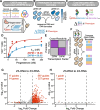Precise measurement of molecular phenotypes with barcode-based CRISPRi systems
- PMID: 40414878
- PMCID: PMC12103760
- DOI: 10.1186/s13059-025-03610-w
Precise measurement of molecular phenotypes with barcode-based CRISPRi systems
Abstract
Genome-wide CRISPR-Cas9 screens have untangled regulatory networks driving diverse biological processes. Their success relies on interrogating specific molecular phenotypes and distinguishing key regulators from background effects. Here, we realize these goals by optimizing CRISPR interference with barcoded expression reporter sequencing (CiBER-seq) to dramatically improve the sensitivity and scope of genome-wide screens. We systematically address technical factors that distort phenotypic measurements by normalizing expression reporters against closely matched promoters. We use our improved CiBER-seq to accurately capture known components of well-studied RNA and protein quality control systems. These results demonstrate the precision and versatility of CiBER-seq for dissecting cellular pathways.
Keywords: CIBER-seq; CRISPR/Cas9; Massively parallel reporter assay; Nonsense-mediated decay; Protein quality control.
© 2025. The Author(s).
Conflict of interest statement
Declarations. Ethics approval and consent to participate: Not applicable. Consent for publication: Not applicable. Competing interests: N.T.I. holds equity and serves as a scientific advisor to Tevard Biosciences, and holds equity in Velia Therapeutics. J.H.L. declares no competing interests.
Figures




Update of
-
Precise measurement of molecular phenotypes with barcode-based CRISPRi systems.bioRxiv [Preprint]. 2024 Jun 22:2024.06.21.600132. doi: 10.1101/2024.06.21.600132. bioRxiv. 2024. Update in: Genome Biol. 2025 May 25;26(1):142. doi: 10.1186/s13059-025-03610-w. PMID: 38948701 Free PMC article. Updated. Preprint.
Similar articles
-
CRISPRi with barcoded expression reporters dissects regulatory networks in human cells.bioRxiv [Preprint]. 2024 Sep 6:2024.09.06.611573. doi: 10.1101/2024.09.06.611573. bioRxiv. 2024. PMID: 39282439 Free PMC article. Preprint.
-
Precise measurement of molecular phenotypes with barcode-based CRISPRi systems.bioRxiv [Preprint]. 2024 Jun 22:2024.06.21.600132. doi: 10.1101/2024.06.21.600132. bioRxiv. 2024. Update in: Genome Biol. 2025 May 25;26(1):142. doi: 10.1186/s13059-025-03610-w. PMID: 38948701 Free PMC article. Updated. Preprint.
-
CiBER-seq dissects genetic networks by quantitative CRISPRi profiling of expression phenotypes.Science. 2020 Dec 11;370(6522):eabb9662. doi: 10.1126/science.abb9662. Science. 2020. PMID: 33303588 Free PMC article.
-
New Developments in CRISPR/Cas-based Functional Genomics and their Implications for Research Using Zebrafish.Curr Gene Ther. 2017;17(4):286-300. doi: 10.2174/1566523217666171121164132. Curr Gene Ther. 2017. PMID: 29173171 Review.
-
CRISPRi and CRISPRa Screens in Mammalian Cells for Precision Biology and Medicine.ACS Chem Biol. 2018 Feb 16;13(2):406-416. doi: 10.1021/acschembio.7b00657. Epub 2017 Oct 24. ACS Chem Biol. 2018. PMID: 29035510 Free PMC article. Review.
Cited by
-
Mapping the Genetic Architecture of the Adaptive Integrated Stress Response in S. cerevisiae.bioRxiv [Preprint]. 2024 Dec 22:2024.12.19.629525. doi: 10.1101/2024.12.19.629525. bioRxiv. 2024. PMID: 39763758 Free PMC article. Preprint.
-
CRISPRi with barcoded expression reporters dissects regulatory networks in human cells.bioRxiv [Preprint]. 2024 Sep 6:2024.09.06.611573. doi: 10.1101/2024.09.06.611573. bioRxiv. 2024. PMID: 39282439 Free PMC article. Preprint.
References
-
- Przybyla L, Gilbert LA. A new era in functional genomics screens. Nat Rev Genet. 2022;23:89–103. - PubMed
MeSH terms
Grants and funding
LinkOut - more resources
Full Text Sources

